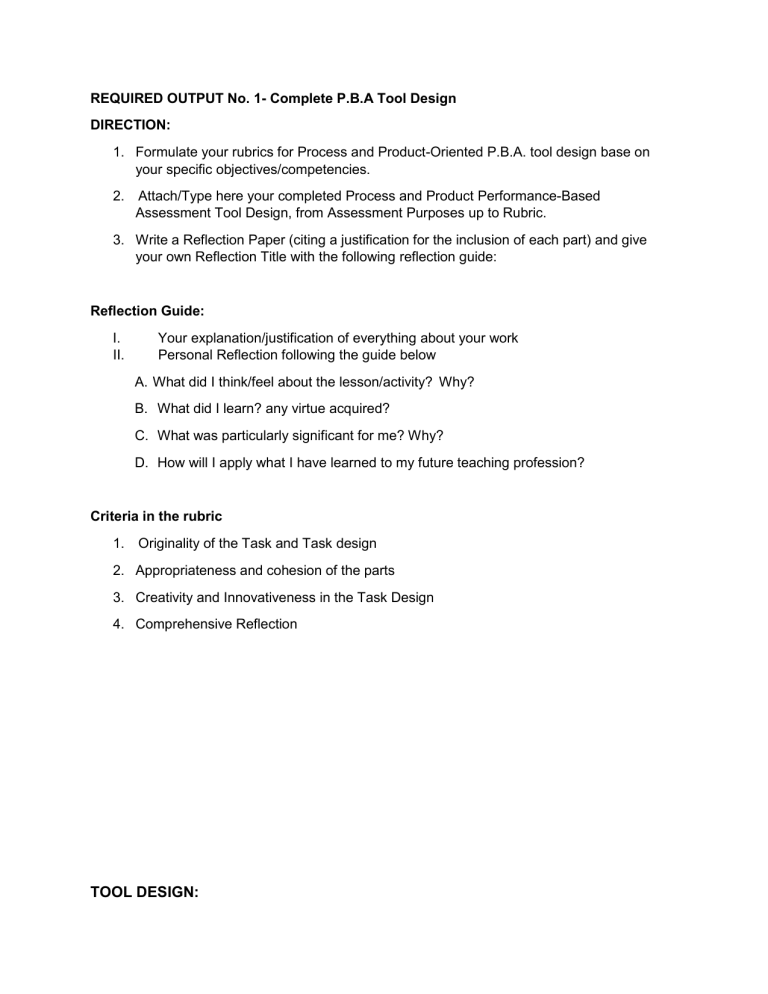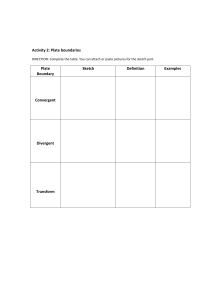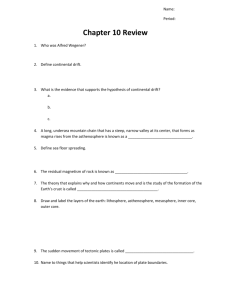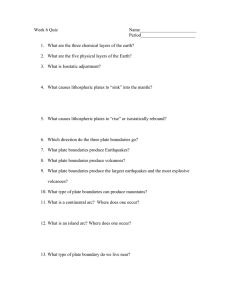
REQUIRED OUTPUT No. 1- Complete P.B.A Tool Design DIRECTION: 1. Formulate your rubrics for Process and Product-Oriented P.B.A. tool design base on your specific objectives/competencies. 2. Attach/Type here your completed Process and Product Performance-Based Assessment Tool Design, from Assessment Purposes up to Rubric. 3. Write a Reflection Paper (citing a justification for the inclusion of each part) and give your own Reflection Title with the following reflection guide: Reflection Guide: I. II. Your explanation/justification of everything about your work Personal Reflection following the guide below A. What did I think/feel about the lesson/activity? Why? B. What did I learn? any virtue acquired? C. What was particularly significant for me? Why? D. How will I apply what I have learned to my future teaching profession? Criteria in the rubric 1. Originality of the Task and Task design 2. Appropriateness and cohesion of the parts 3. Creativity and Innovativeness in the Task Design 4. Comprehensive Reflection TOOL DESIGN: Product-Oriented Performance-Based Assessment Tool Design Assessment Purpose: To track students’ growth and diagnose their strength and weaknesses. To provide coaching and feedback to students. To provide basis for grading involving criterion-referenced approach. Target: Grade 10 students Construct: knowledge on tectonic plate boundaries General Objectives: Using recyclable materials, the students should be able to create/produce functional models for 3 types of plate boundaries. Specific Objectives: The plate boundaries models that the students will create must: 1. be a functional model for each type of tectonic plate boundaries. 2. be created using recyclable materials such as cartons, Styrofoam, papers, sticks etc. 3. be in a functional mode in a way that it can show how plates move based on its type. 4. be properly labeled and have proper description. 5. includes the type and as well as the arrows of movement direction 6. have each model be put in a 1/4 illustration board. 7. Cite at least one example of each tectonic plate boundaries. 8. possess a picture of the example beside the description of each model. 9. be neat and has a pleasant appearance with the inclusion of proper color on parts of the model; and 10. depict team effort. RUBRICS: CRITERIA Excellent 3 Average 2 Poor 1 % Functionality of the models The models’ functional mode excellently demonstrates the right movement of the different plate boundaries The models’ functional mode only demonstrates some of the movement of different plate boundaries The models’ functional mode does not demonstrate the right movement of the different plate boundaries 25% Some parts of the models were not made of recyclable materials; putted on the wrong sizes and type of board; The models do not utilize recyclable materials, incorrect presentation of 20% The models are made up of Appropriateness recyclable materials; of materials in right size of illustration board have attached pictures of the examples of each of the plate boundaries Correctness of form and descriptions Creativity and Neatness Promptness The models depict their understanding of the topic through proper labeling, such as it has complete description of each type, correct direction of arrows according to each movement, and provided correct/ accurate examples of each type of plate boundaries The models are creatively made and has used appropriate colors; and are neat. The overall appearance is a result of careful and meticulous planning Submitted on or before the deadline only provided some pictures of the examples the models, does not provide picture evidence of the examples The models were labeled and has descriptions and examples, but were incomplete and needs improvement There are some errors on the arrows directions. The models are not labeled and no descriptions. Incorrect arrows’ direction and no examples provided 25% The models were made right but needs improvement on the use of appropriate colors and neatness The models were dull and empty. Showed little evidence of effort or planning. 20% Submitted one day after the deadline Submitted 2 days and above after 10% the deadline Process-Oriented Performance-Based Assessment Tool Design Assessment Purpose: To track students’ growth and diagnose their strength and weaknesses. To provide coaching and feedback to students. To provide basis for grading involving criterion-referenced approach. Target: Grade 10 students Construct: ability to show their competencies on presenting their knowledge and understanding about plate boundaries General Objectives: The students should be able to comprehensively explain and show their understanding about the types of plate boundaries using their functional models through a selling themed presentation Specific Objectives: In the presentation, the students should be able to: 1. utilize their functional models of plate boundaries as their product to sell. 2. demonstrate the movements of the plate boundaries through the functionality of their models. 3. comprehensively explain and discuss about each type of plate tectonic boundaries without turning away from the theme 4. elaborate the causes of the movements of plate boundaries as well as the effects in geology and people’s lives 5. gives real-life existing examples of each type of boundaries 6. depict their team effort through their own creativity and uniqueness of their presentation RUBRICS: Score Criteria 4 The presentation comprehensively explained/discuss the concepts without turning away from the theme and demonstrate those concepts effectively through the functionality of their models. Presented accurate and correct real-life examples. The performance execution is unique and original. The audience were highly engaged and focused on the presentation 3 The presentation averagely discussed the concepts and has utilized their models’ functionality without turning away from the theme. Presented some real-life examples. The performance is averagely good and unique. The audience are focused and listening. The presentation only discussed minimal information about the concept and does not properly utilize the functionality of their models. The theme was sometimes forgotten. Presented minimal examples. The performance may contain errors and the audience’ attentions are not hooked. The presentation gives a very limited explanation about the concepts and the functionality of models were not utilized. Theme is often neglected. The performance was disorganized and is dull. 2 1 Task Design: TECTONIC PLATE BOUNDARIES “I SELL MODELS” GOAL: This activity will determine the understanding of the students about different types of tectonic plate boundaries through creating functional models and presenting real-life examples. This will develop the student’s creativity, collaboration, and presentation skills. TASK DESCRIPTION: To accomplish the activity, the students will be grouped consist of 3-5 member per group. They will be tasked to produce or create a functional model for each type of tectonic plate boundaries. The students will be given an enough amount of time to finish the project. The functional models should have the following specifications: - It should be made up of recyclable materials. It should rightfully show the type of the plate boundaries through its functionality It should be properly labeled and have proper description. It should have a neat and pleasant appearance. After they have produced/created their functional model, each group of students will present their models in front of the class. ROLE: The students as an online seller or salesman. AUDIENCE: The teacher and classmates as the customers SITUATION: In your presentation, suppose that you are an online seller or a salesman trying to promote your product. Using the functional model of tectonic plate boundaries that you have created, try to promote, and sell those models in your own creative ways. Your promotion should include the description about the different plate boundaries, their cause and effects on geology and people, as well as the real-life example of each type. Your functional models and presentation will be judged by your classmate through rating basis depending on the presentation impact and their preferences. Thus, your overall output and presentation will be graded through the criteria given. PRODUCT: The students will produce a functional model of different tectonic plate boundaries. REFLECTION: “What a Fulfilling Experience” The careful and effective formulation of performance task is an essential skill and knowledge that every educator should possess. And as a future educator like me, this activity helped me to develop such skills. I have made a performance task about the topic of plate boundaries under the grade 10 MELCs at the first quarter. I have also made that the product-oriented based and processoriented based performance task is set to be successive. Wherein, the students were first tasked to provide or create a product (product-oriented based task) which is to create a functional model of each type of the plate boundaries, then they will present their functional models (process-oriented based task) with a particular theme of ‘selling product’, in front of the class. Each tool design has their own rubrics. For the product-oriented task, I have utilized the analytic rubric to score or grade the students’ work. This is because the assessment purpose of this product-oriented task is to diagnose the strength and weaknesses of the students’ understanding about the concept or topic. Wherein those characteristics would be reflected on the product they will produced and is to be evaluated using the provided analytic rubric. On the other hand, I have used a holistic rubric to evaluate the process-oriented performance task. That is because the process-oriented task is a performance or presentation, in which should be graded/evaluated as a whole. Where in it particularly judging the quality of the overall achievement of the presentation and not just by assessing individual characteristics or criteria. And through these two rubrics, I believe that it will justify and prove the effectiveness of this task design and will be able to affectively evaluate the students’ performance. In this activity, if I were to be honest, I really do have a difficulty on thinking what appropriate task that should be given on the students during that topic. Considering that is should be authentic and doable. However, once I have come up with the right idea, I honestly enjoyed doing it, though there are times and circumstances that I don’t know what I should write, or the terms I want to express while doing it suddenly leave my mind. But I am thankful that I am well guided, by the discussion we have and by the materials available. And that abled me to finish this activity. Upon doing these activities, part by part, I learned that a teacher should be really a critical thinker and always thinking outside the box. Aside from the knowledge, a teacher should be a creative and critical thinker to formulate or create an effective product and task that can help students to improve. And the skill in doing so is also important, which I can say that I have acquired that upon doing this activity. I think after I have fully finished this activity, and now that I am writing my reflection, I felt a sense of fulfillment or achievement right now. That I am now able and capable on doing things that I find difficult before and is the things that I will surely do in the future. I will always remember and go back to that feeling of thinking what appropriate task should be in a particular topic and how, ‘as a teacher’ to carry that out on the students. And that is something that would be always a part of me as I walk on my path on becoming a future educator.





